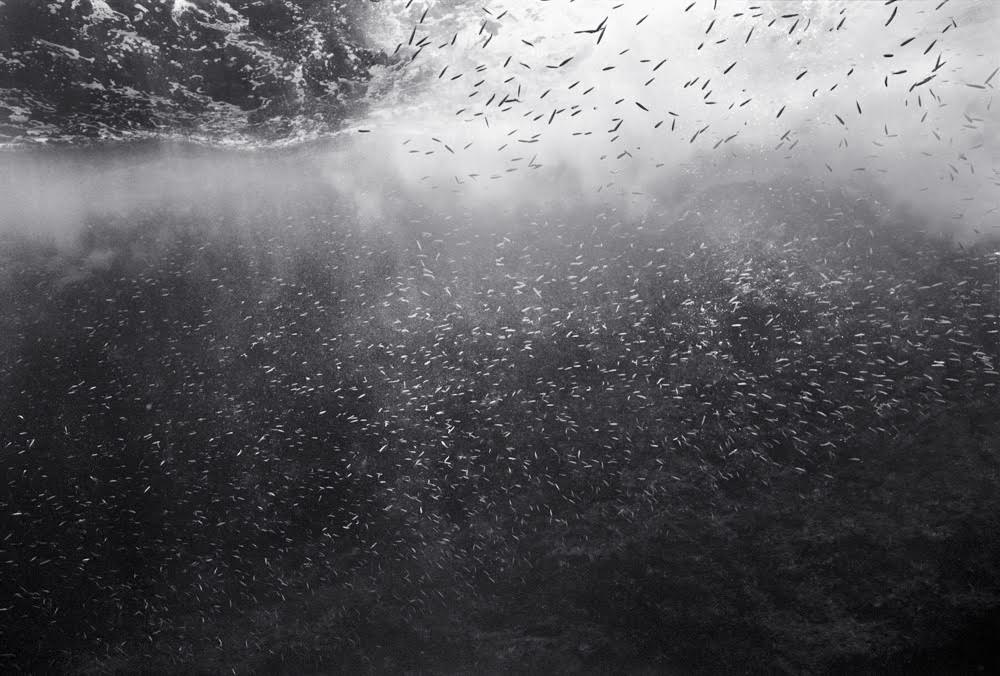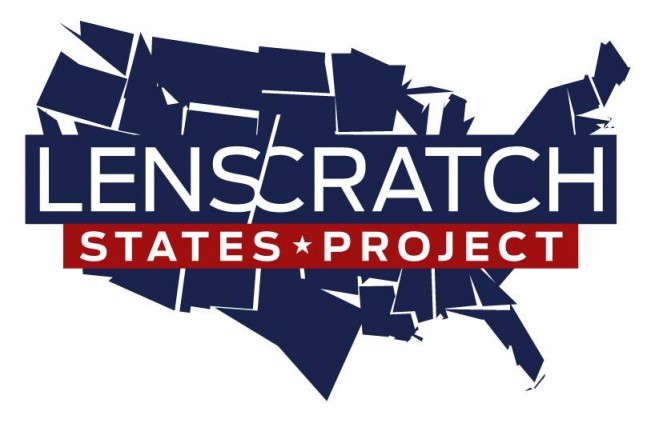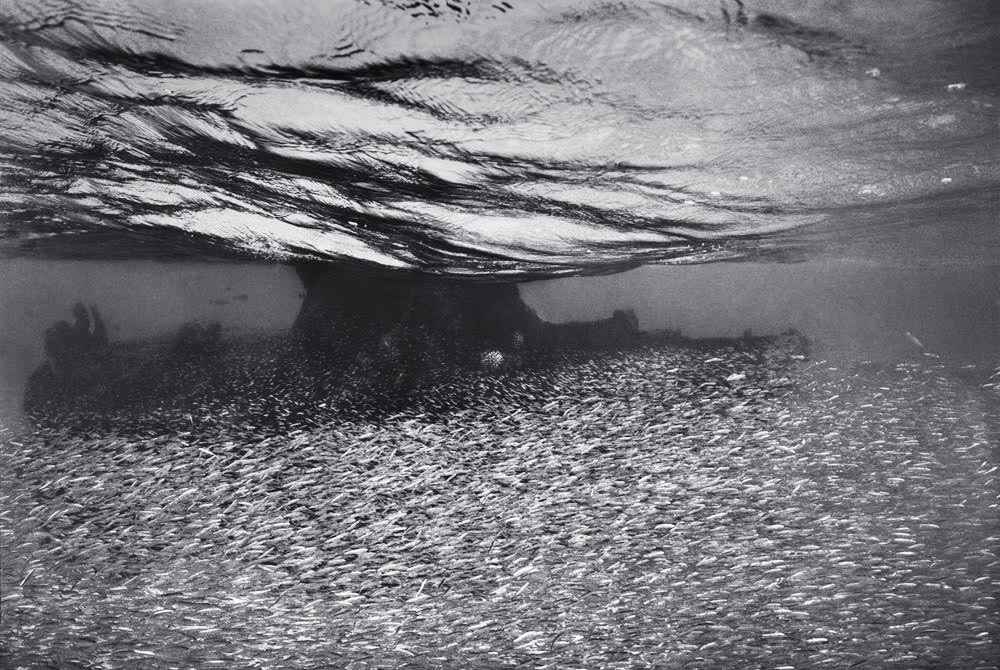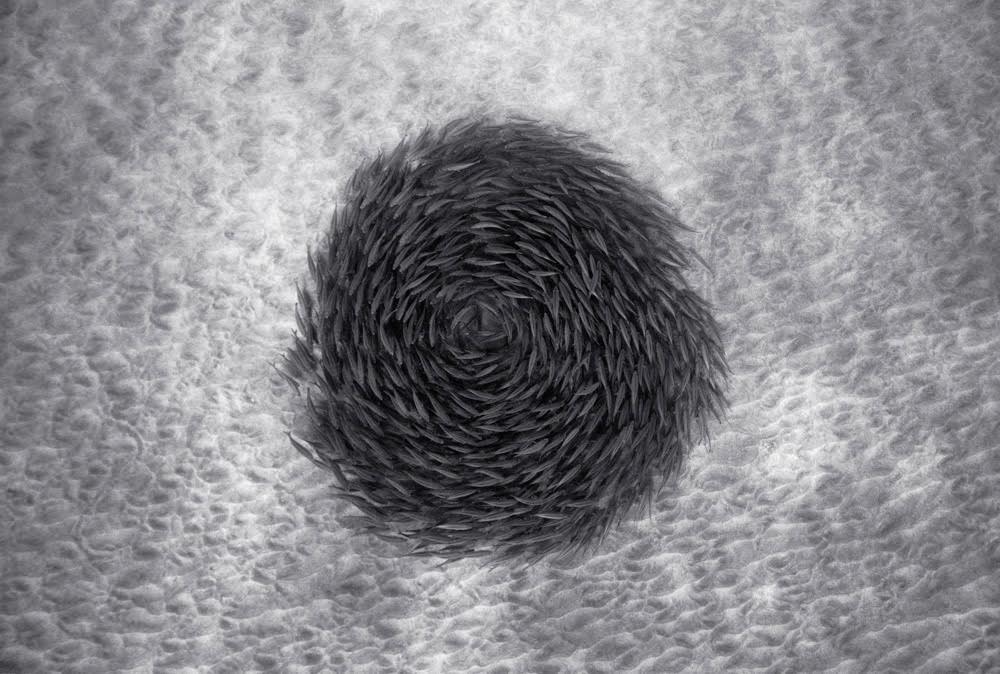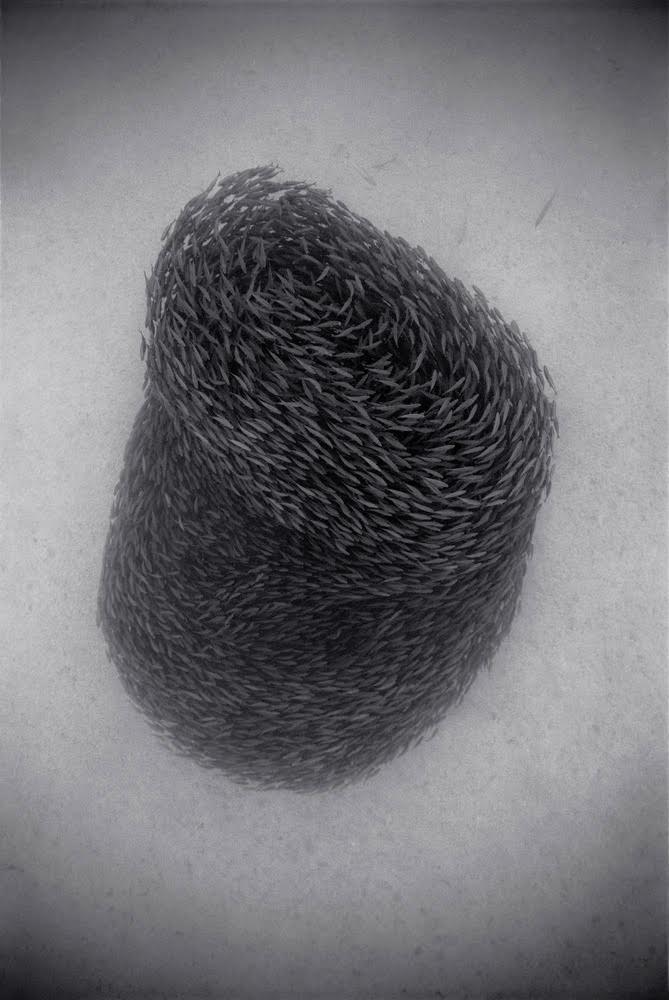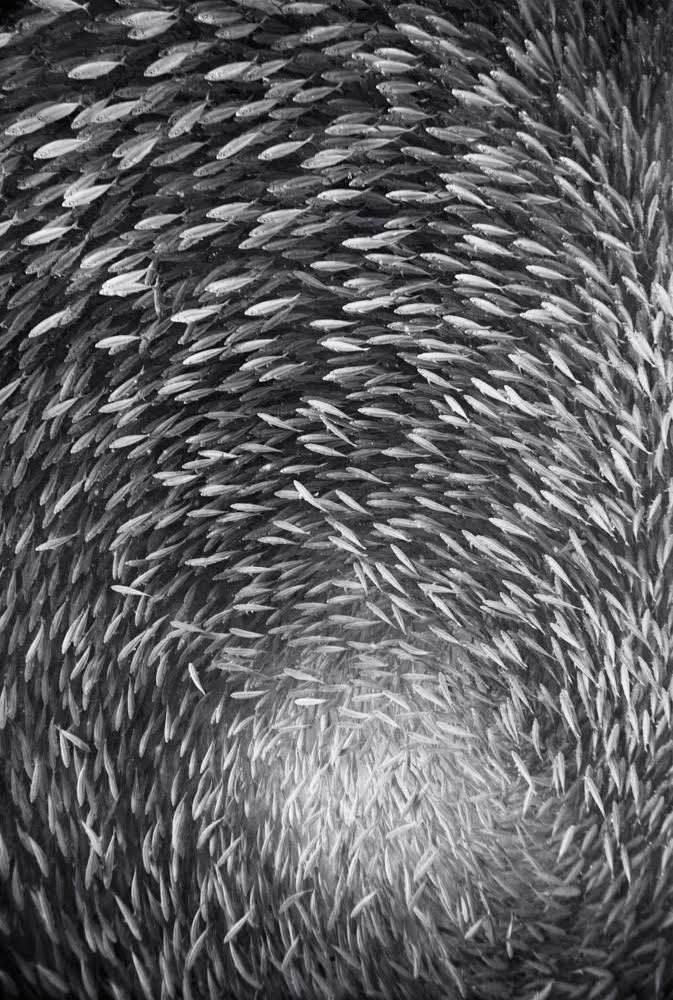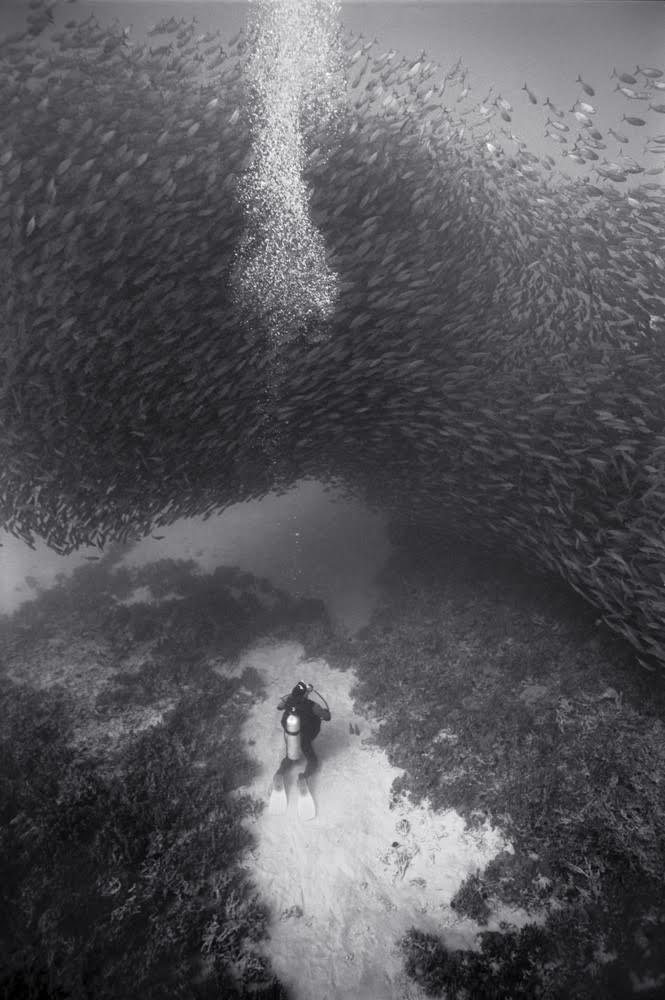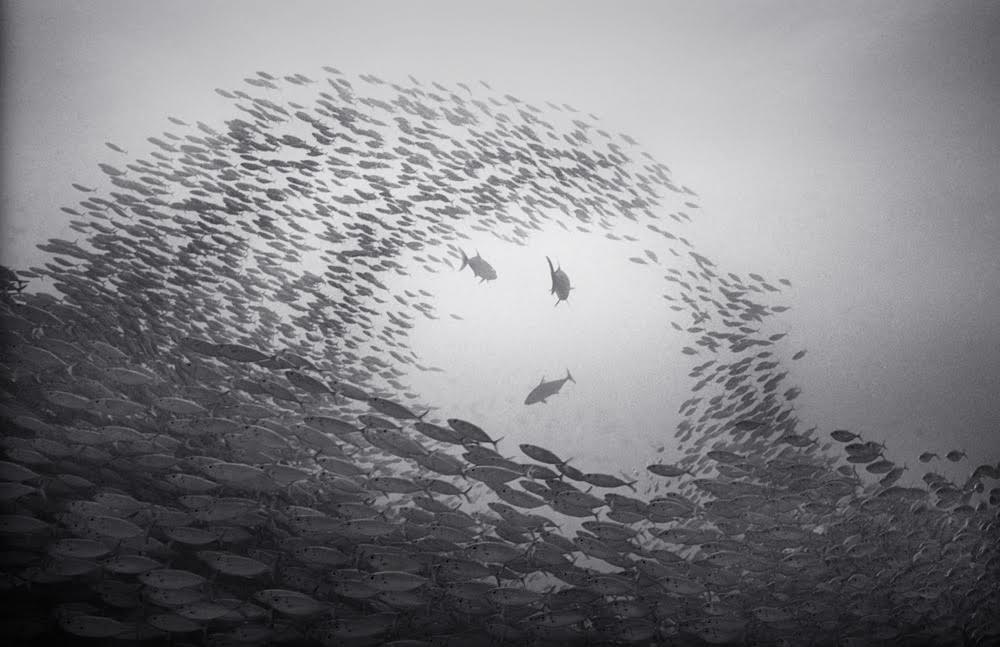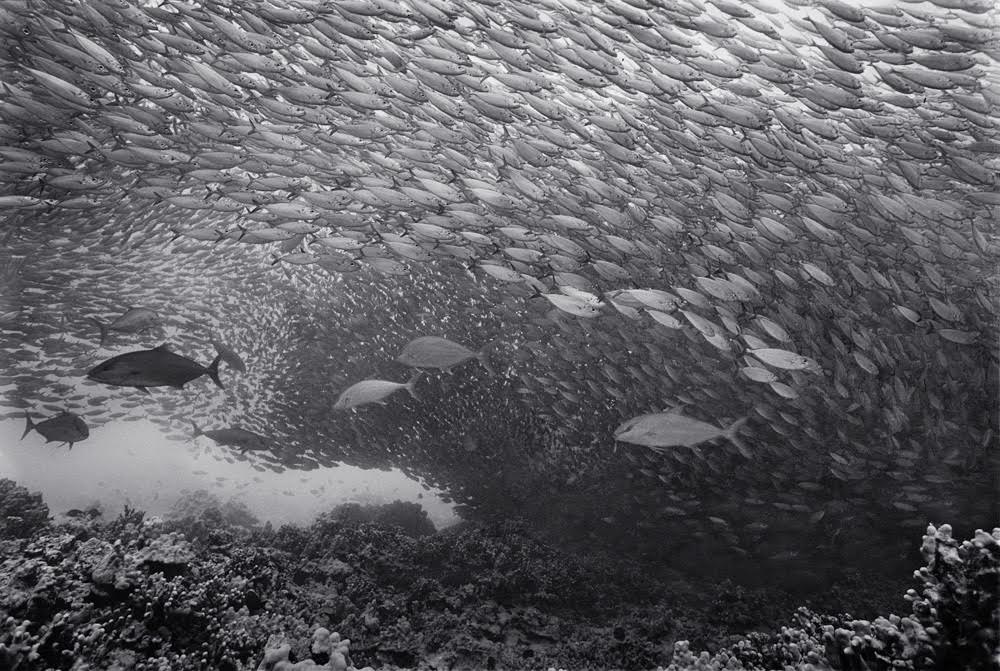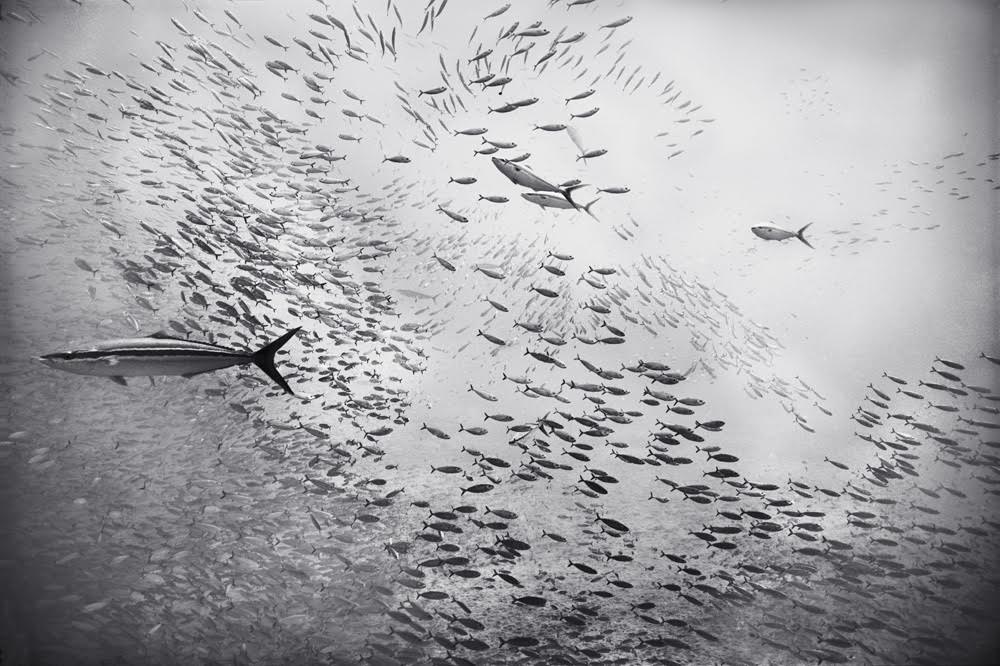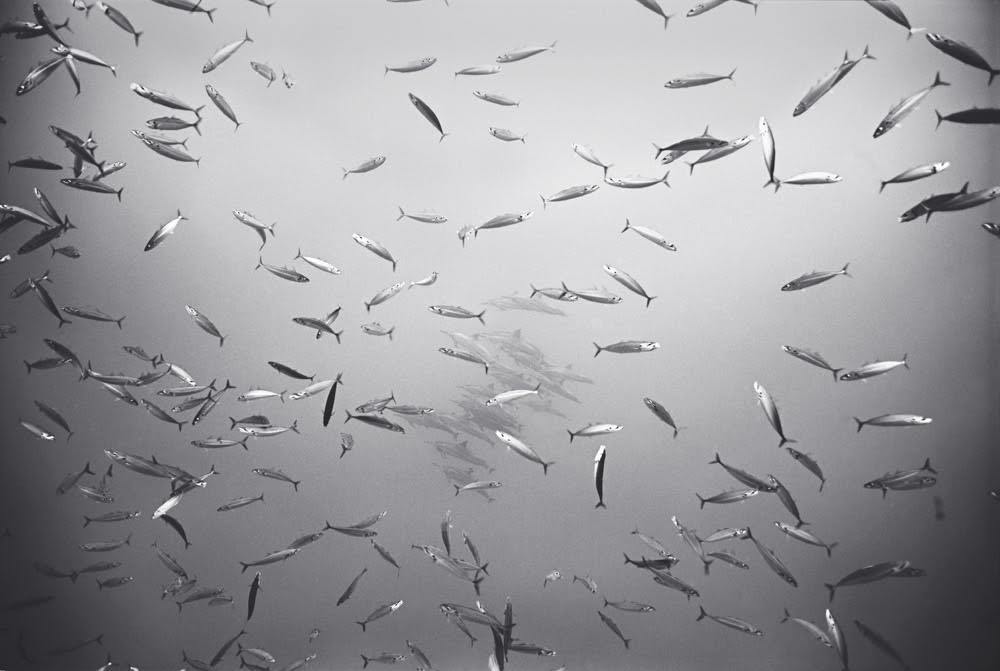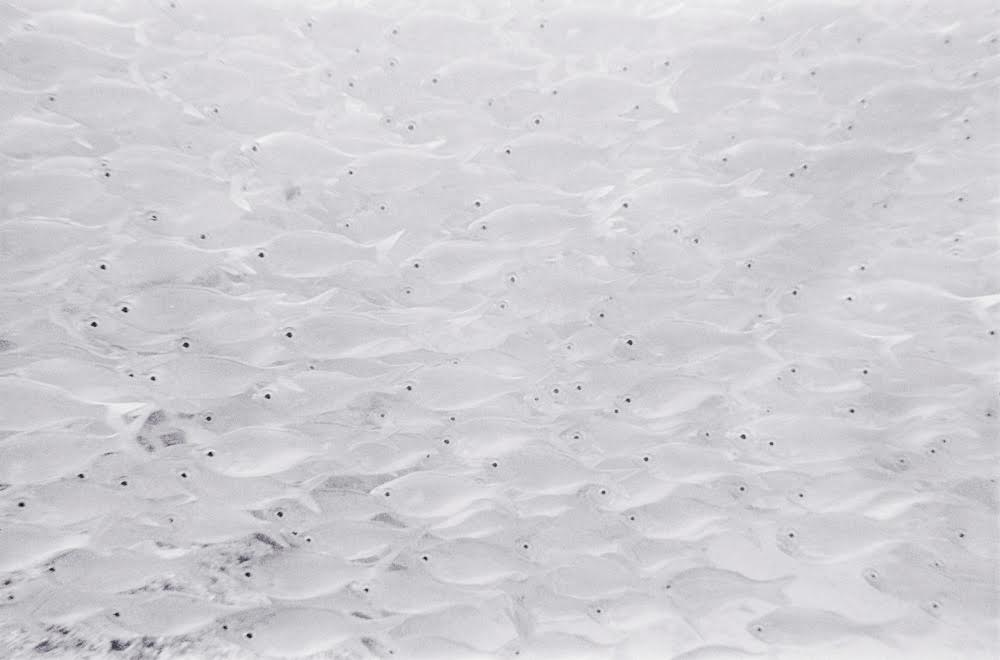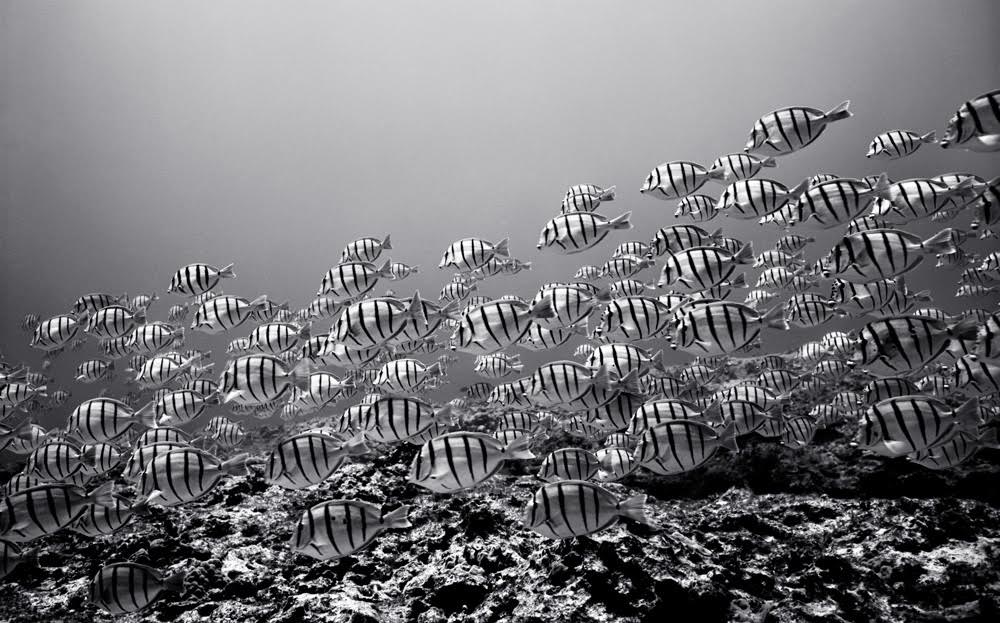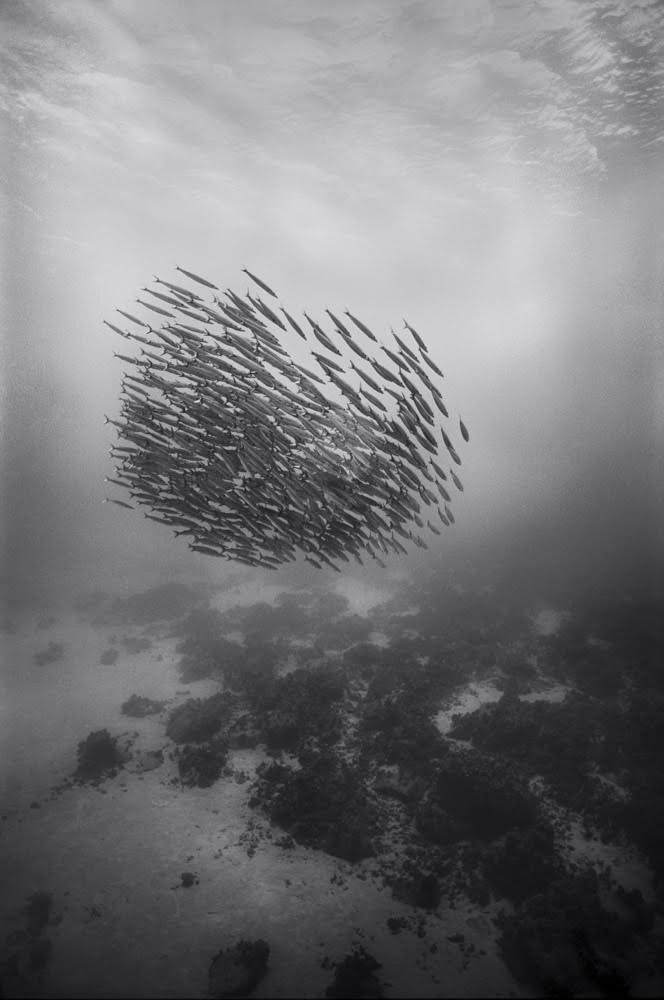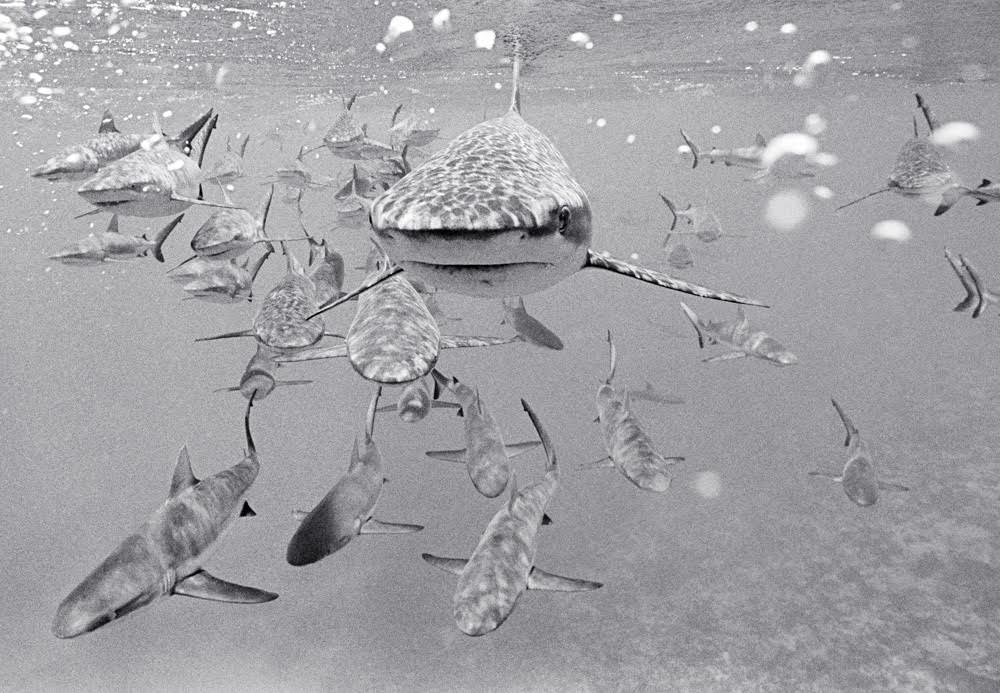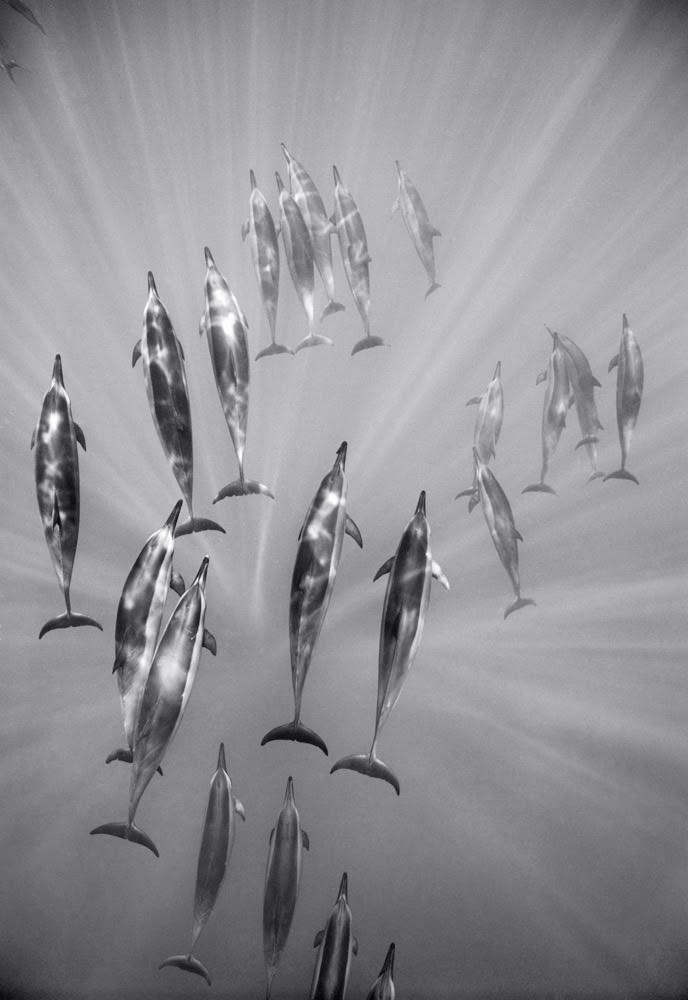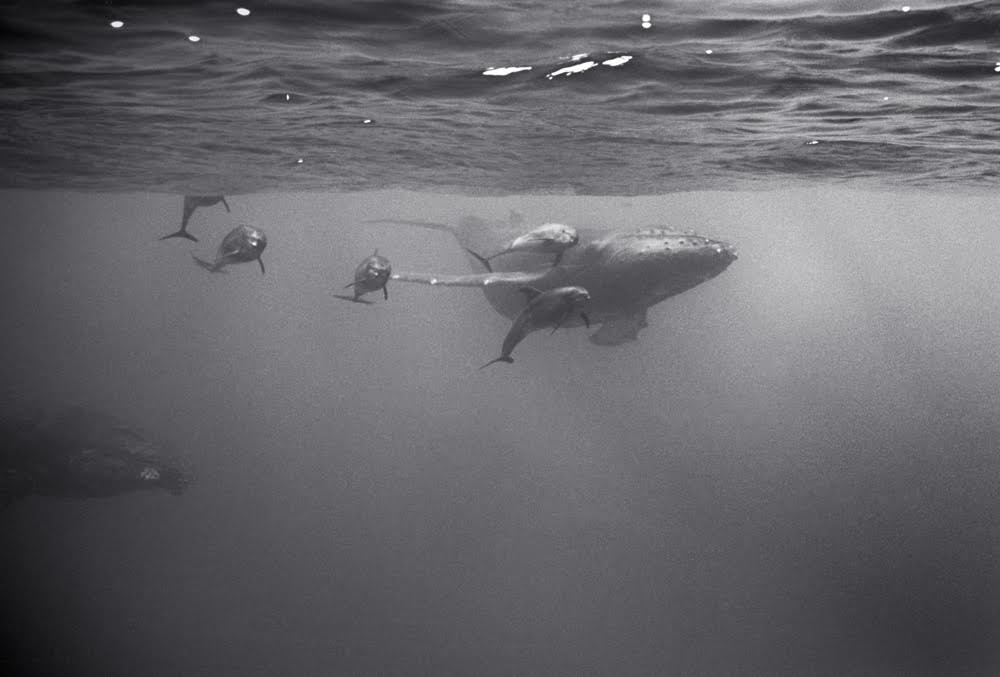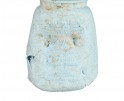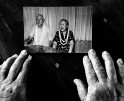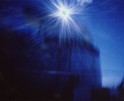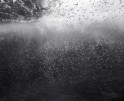Wayne Levin: The States Project: Hawaii
Wayne Levin and I met very briefly during a group exhibition where he was sharing a space to show his work with the South Kona Artist Collective at SKEA [ Society for Kona’s Education and Art ] on Big Island. I came to know Wayne’s work a little better over the following two years, having the chance to encounter a book of his work that Sangyon Joo published with Datz Press, and most recently enjoying his company along with Linda Connor during a visit to my place also on Big Island. Two things come to mind when I look again through is work and think of the meetings I’ve had with him: the awe that Hawai’i tends to fill in any of us, crystal clear in his work; and the visual “ear” he seems to carry with him innately.
By a “visual ear” I mean he both listens very intently when conversions with him, a rare and special quality, and he also seems to listen with his eyes, his ears, all his senses, to the seas and underwater worlds he visits and experiences, sharing them through his images.
I felt very lucky to have had the opportunity to look more carefully through his work with “Akule ( Fish Schools ), because the more one looks the more one sees that he has a most skilled manner in which he expresses his experiences deep in the sea – he takes in and truly absorbs with admiration, appreciation and wonder at his subjects as if to almost reiterate to and remind the rest of us how full of majesty our world is and how precious to be a part of it.
Wayne Levin has been photographing the land and oceans since the early 1970s. A resident of Hawai‘i since 1968, he received his BFA from the San Francisco Art Institute and his MFA from Pratt Institute in New York. His books and monographs include Kalaupapa: A Portrait (1989), documenting the Leprosy Settlement on the island of Moloka‘i; Through a Liquid Mirror (1998), and Other Oceans (2001), Akule (2010), Ili Na Ho’omanaa’o o Kalaupapa 2012, and Flowing 2014. Levin’s photographs were also included in Kaho‘olawe: Na Leo o Kanaloa (1996) and have appeared in such publications as Aperture, American Photographer, Camera Arts, and LensWork. He has received fellowships from the National Endowment for the Arts (1984); the Ohio Arts Council (1989); and the Hawai‘i State Foundation on Culture and the Arts (2006). Widely exhibited, his photographs are in major public collections including the Museum of Modern Art, New York; Museum of Photographic Art, San Diego; The Maritime Museum, Newport News, Virginia, The Dimbola Museum, UK, The Datz Museum, South Korea, The National Academy of Sciences, The Honolulu Museum of Art, Honolulu; and the Hawai‘i State Foundation on Culture and the Arts.
Akule (schooling fish)
I feel that the Ocean is an entity of incredible power, and every time I enter the ocean I am very clear that I am putting myself within a world that is far more powerful and vast than me, and it is only by its grace that I return. When I descend beneath the surface, I feel like I am Alice passing through that looking glass into a totally different world. Or am I Cocteau’s Orpheus passing through the mirror into the underworld? When I descend beneath the surface I am in a world with different rules, different truths. Things look different, light acts differently, gravity pulls differently. One can fly, or at least float over the landscape, or seascape. When I descend into this wonderland, I want to make images, not to explain or clarify that world, but to deepen the mystery.
For the past 12 years I’ve been compelled to photograph schooling fish, focusing on Akule (Big Eyed Scad–Selar crumenophthalmus). These images were taken at Kealakekua Bay and Keauhou Bay on the Kona Coast of the Island of Hawaii, and Waimea Bay on Oahu’s North Shore.
The Akule, about six inches in length, are found in miraculously formed clusters of from several hundred fish to one hundred thousand. These tightly packed clusters move with astounding coordination. Viewed as a whole, the school appears to be living sculpture, constantly changing shape as predators approach and interact with it.
A prevalent piscine behavior, schooling may reduce friction for individual fishes, and/or confuse predators by presenting a single large mass or offering too much shifting visual data. Observing these extraordinary groupings, one may come to question if the individual is the single fish or the school, with individual Akule like a cell of a larger entity. And, one comes to wonder, what might this question suggest about humans – -our relationship with each other, and, of course, our relationship with other forms of life.
You end your statement with a most beautiful and poetic sentiment — “When I descend into this wonderland, I want to make images, not to explain or clarify that world, but to deepen the mystery.” This perspective is wonderfully clear in your work. Do you feel you’ve approached much of your life in this way? Or do you feel you had a journey to come to this view, or?
My quote “when I descend into this wonderland I want to make images not to explain or clarify that world, but to deepen the mystery” actually combines two concepts I have about my underwater work. The first is the idea of passing through this infinitely thin membrane, called the surface” that separates two very different worlds. Its like Alice passing through the looking glass into another world. In fact I titled the first book of my underwater work “Through a Liquid Mirror” an obvious reference to “Through the Looking Glass”. In fact one of my favorite exhibits of my work was at the Dimbola Museum, on the Isle of Wight off the south coast of Britain. The Dimbola Museum was the home of the great Victorian photographer Julia Margaret Cameron, who happened to be a close acquaintance of Louis Carroll. There was a real Alice about whom Carroll’s stories were written, Alice Liddell. Louis Carol photographed Alice as a young girl of 8 years old. Later the Liddell family became neighbors of Mrs. Cameron, and JMC photographed Alice at the age of 20. I felt it was such an honor to show this work not only in the home of Julia Margaret Cameron, but in a home that had such a strong relationship to Alice in Wonderland. Both Louis Carol, and Alice Liddell spent many hours in that house.
The second part of that quote about making images that deepen the mystery rather than clarify the underwater world, stems from a thought I had one day after swimming with Dolphins. For the past several years my work had been moving closer to wildlife photography. I was obsessed with photographing as many different species of large aquatic animals as possible. I must say that there are many amazing wildlife photographers, and I really love and respect their work. But it seemed that my work, and my vision was different. For one thing, my images of animals seemed to be at least as much about the space around them, or the relationship between the animal and its environment. Often I preferred images where the animal was further away, rather than close-ups. I was thinking about these things, and why I wasn’t really a wildlife photographer, when I had the realization that I did’t want to explain that world. I’d rather the viewer be left wondering about a world that we can’r really understand anyway.
I don’t feel that I am able to live my life in realization of the mystery. In my day to day life, I’m a bundle of uncertainties, hopes, anxieties, anger, joy, tension, and relaxation, just like most humans. I do however often have a strong philosophical bent, and a drive that borders on obsession with my photography. I do feel that often I learn and get new ideas or concepts from my photographs. They teach me and open up new possibilities.
If you could re-live a certain experience you’ve had in your many ventures below the sea, what is one of them; why?
This is a hard question. I’m assuming you mean to relive, exactly the way I lived it the first time. Otherwise, there’s about a hundred times I wish I didn’t take so many stupid pictures early in a dive, only to run out of film then have something really amazing happen, and my only images are memories.
It’s hard to pick just one experience, though many of the most memorable experiences I would not want to relive. But here’s one that comes to mind. My cousin came to visit with her husband and young daughter. I hadn’t seen her since she was a young teen. She became quite an adventurer, i.e. bicycled across Africa by herself. We had a picnic at Honaunau on the beach. Though she was 8 months pregnant, she decided she wanted to go snorkeling. So while snorkeling we saw dolphins out in the bay. She wanted to swim out to them. When we approached them. At first they kept a distance, but then they started circling us in very tight circles, sometimes coming within arms length distance. They were clicking like crazy. I’m sure that they were echo-locating her fetus. Of course I didn’t have my camera.
You didn’t always live in Hawai’i. What are some of the things you feel changed in you once here, or were perhaps brought out in you, if anything, and what are some of the things that drew you here to begin with?
Actually my parents moved here in 1967 when I was in the Navy. When I got out in 1968, I followed them here. Although growing up in LA, my family was into racing sailboats, and I used to go fishing with my friends, it wasn’t until I moved to Hawaii that I really fell in love with the ocean. It was first through surfing, especially body surfing that I really became in tune with the ocean. My favorite spot was Makapu’u on the east tip of Oahu. I would spend days riding waves. Later, my parents moved to Kona, and it was there that I really got into snorkeling and free diving. Later I took up scuba diving when I got an assignment with Pacifica, the Continental Air Micronesia magazine to go to Yap to photograph huge Manta Rays. A few days after getting scuba certified I was on a plane to Yap in western Micronesia. On my first dive after being certified the guy who ran the dive company there took me to the outer reef. When he turned on his air, he blew his high pressure hose. He said he had to go back to get a new hose, but I should just go down there and follow the drop-off and I would come to a coral bridge. Just wait on the side of the bridge, and the giant mantas will swim by. I’ll be back to pick you up in an hour. So that was my first real dive, and Mantas with 16-18 foot wingspans did come by.
Also in Hawaii I increased my technical ability in photography tenfold. I was lucky to get a job as the darkroom man for renowned Hawaii photographer Robert Wenkham. I especially learned a lot from Wenkham’s assistant Augie Salbosa who was a masterful Architectural photographer.He also taught me much more about the darkroom then I ever learned in school.
On a macrocosmic as well microcosmic level, what are some of the issues you feel you talk about through your work, and what are some you think a being covered in symbiotically parallel ways in fields other than art, and where?
I guess both macro and microcosmic issues are combined in my Akule Fish School work. The primary question that I’m asking in this work is; what is the individual? The school acts, and appears so much like a single being, that you really have to wonder if the single fish is the individual, or are they part of a larger being, the school. Are the individual Akule like cells of a larger entity. And when you ask that, the question that follows is are we entities unto ourselves or are we just a part of a larger being, humanity? And is humanity just a part of a larger being, the living earth? So could all life on earth be like the cells that make up the larger entity, the earth. If so, an individual that acts like they are not connected to the larger whole, and is a single being unto itself is much like a cancer cell. Could the earth be suffering from a malignancy of its humanity?
There is a lot of research on the behavior of schools, flocks, herds, swarms. A lot of it has to do with spacing, movement, and communication. Other research has to do with the benefits and liabilities of this behavior. Some of it has to do with the connections between living entities, and deals with the same questions that I just asked.
You clearly have a deep, meaningful and I would say spiritual connection to not only the ocean itself, but seemingly also to the sense of “wonder” and “mystery” it instills in you about which you write. Can you talk about what this sense of mystery means to you, and might have meant to you growing up? — Do you think that sense [ of mystery ] is essential to our lives as a humanity and as individuals finding our paths?
Maybe the sense of mystery is just an accepting that there are a lot of things that humans can’t know. That are beyond our understanding, beyond the scope of our mind. We can theorize about these things, but we can’t know, it’s a mystery. In my underwater photography, I think my main tool for conveying this sense of mystery is by being a little out of control. Things often happen so fast that I’m just reacting, and often don’t know what I’m capturing on film until I see the negatives, or contact sheets. Especially my underwater work of surfers. Not only would the figures appear and disappear almost faster than I could be aware of them, but the visibility would go from 100 feet to 3 feet within a second. So my sense of mystery included a sense of mystery about what I was actually capturing on film. Sometimes images would happen that seemed to come out of nowhere. Images I could never pre-visualize.
What’s one thing you’ve come to know, think, believe, feel about the ocean that maybe you didn’t upon first encounter?
I wasn’t aware how powerful the ocean was. Of course as a small kid I used to go to Santa Monica Beach, and get “washing machined” by the small waves”, which was quite scary at the time. And while the power of the ocean can be manifested in huge waves, and hurricane force winds, the more subtle, and I think dangerous power of the ocean is in its currents. There’s countless stories of divers or swimmers, just being swept away by an ocean current, never to be seen again. I myself have had a few experiences when I surfaced from a dive, and my first thought was “oh my god” as I saw how far out to sea I was. There are also downwellings and upwellings, vertical currents. I have a friend who tells the story about being on a safety stop at the end of a dive at Palau, when all of a sudden her ears started hurting. She checked her depth gauge and she was at 100 feet and going down. She was able to inflate her BC, and was okay, but her friend had to go into the recompression chamber. Once off Cocos Island, I was trying to get around a point against a very strong current. I was holding onto the rocks. I decided I wasn’t going to get around the point, so I let go. Not only was I swept back, but I was also swept up from perhaps 50 feet down to the surface in a matter of seconds. A very dangerous occurrence, I could have gotten an air embolism.
I’ve also learned about the fragility of the sea. So many types of sea life, which were once more than plentiful, are now endangered or extinct. For example, the Hawaiian Monk Seal is on the verge of extinction. Last I heard, there were about 1000 left, mostly in Papahanaumokuakea Marine National Monument (the Northwest Hawaiian Islands).The survival rate for Monk Seals in the first year of life is 10%. In the fall of 2015 Kona had a major coral bleaching event, which killed 50% of our coral. This was caused by extremely hot water temperatures. So I have total disdain for those who question climate change, or who pull the US out of the Paris Climate Accord.
Lastly, what’s a book/movie/quote/person/artist/or place, that’s is giving you inspiration these days?
I am inspired by some classical music, and some jazz, but less so lately. The most inspiring thing lately was from a short passage from a novel I was reading by Salman Rushdie, The Ground Beneath Her Feet. Two of the main characters are a man who is a musical genius, and a woman who is an incredible singer. They had a falling out, and hadn’t seen each other in years. The man gets in an automobile accident, and is in a coma for three years. The woman finally hears about it and goes to his bedside just when he’s dyeing. He’s on his way down the tunnel when she calls him back. So he wakes up. Except when he awakes each of his eyes are seeing into a different universe. One is seeing our universe, what’s in front of him, but the other eye is seeing this similar but different reality. Rushdie describes that it is like there are tares in the fabric of our reality and through these tares he sees this other reality. I think that is an amazing visual description. It would be a challenge to do that photographically.
Posts on Lenscratch may not be reproduced without the permission of the Lenscratch staff and the photographer.
Recommended
-
Laurel Schultz: The States Project: HawaiiAugust 19th, 2017
-
Kent Nishimura: The States Project: HawaiiAugust 18th, 2017
-
Minny Lee: The States Project: HawaiiAugust 17th, 2017
-
Atis Puampai: The States Project: HawaiiAugust 16th, 2017
-
Wayne Levin: The States Project: HawaiiAugust 15th, 2017

